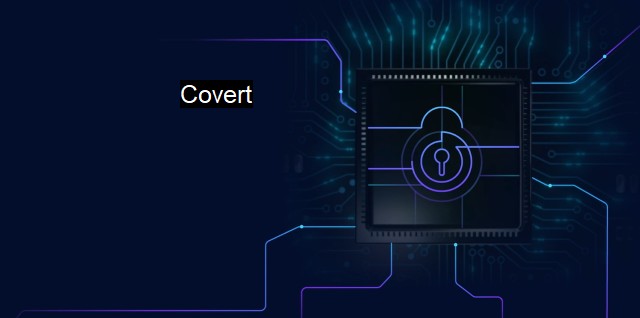What is Covert?
The Rise of Covert Malware: A Growing Threat to Cybersecurity and Antivirus Programs
"Covert" is a term often used in relation to the increasingly important realm of cybersecurity and antivirus software. it refers to hidden operations or actions performed without openly revealing, or disclosing, the identity of the person carrying out the operation. In cybersecurity and antivirus parlance, covert actions typically relate to secretive and malicious activities executed by cybercriminals, meant to compromise the integrity of computers or other digital devices.To understand covert operations in the digital world, one first needs to look at classic tactical warfare. Traditionally, covert operations are carried out by special forces with the objective of entering enemy territory undercover, gathering information, and causing disruptions or damage without being detected by enemy radar.
Similarly, when replicated in a digital environment, covert operations feature equivalent elements. Covert individuals, typically hackers, infiltrate a target's secure digital infrastructure or network with the intent of pilfering sensitive information, causing disruption, or installing malicious software, without being recognized by security systems.
Covert actions typically start with a reconnaissance phase. Hackers monitor a target network to find any loopholes or vulnerability that can be exploited. For instance, very old software might have vulnerabilities that upon manipulation could allow an attacker to trot uninhibited in a computer network.
If vulnerabilities are found, the hackers initiate an exploitation phase where they stealthily infiltrate the target network without triggering any security alarms. These exploitations can take several different forms such as a backdoor, which bypasses regular authentication processes; spear phishing, where malicious information is hidden in seemingly harmless communication; or software specially designed to exploit known software weaknesses.
After gaining unauthorized access, hackers can start disruptive or harmful operations covertly. These could range from data theft and espionage, quietly observing network operations for competitor insights, to much malicious activities such as causing widespread system collapses.
From the antivirus perspective, covert operations translate into the compounded difficulty of detection. Individuals carrying out covert operations use increasingly sophisticated techniques to evade antivirus programmes. They often use hidden identity techniques, cyberattack methods that are not easily recognizable or that trigger antivirus alerts. In this way, covert hackers can operate undetected, sometimes for extensive periods.
One excellent example of covert techniques is the form of malware known as a rootkit. Rootkits are designed to gain illegal access and remain undetectable by exploiting operating system vulnerabilities. Once installed on a system, they give hackers control over the system and can be used to carry out covert operations without getting caught by antivirus software. Likewise, some other covert techniques include encryption of malicious software to prevent detection by antivirus scans, or the use of rapidly mutating malware that changes its own code to avoid being identified.
The fight against covert operations in cybersecurity is important but challenging. The cyber threat landscape constantly evolves, concealing its footprints neatly behind false flag operations, changing attack methods, and advanced persistent threats.
Countermeasures involve continual updating of antivirus software to identify and quarantine new threats as well as novel cyberattack methods and investing resources in preventive measures such as cybersecurity risk assessments and training. With the fast-paced growth in digital rely on for everything from finance to healthcare, understanding, and protection against covert operations in cybersecurity has become crucial for individual users, organizations and governments alike.

Covert FAQs
What does "covert" mean in the context of cybersecurity and antivirus?
In the context of cybersecurity and antivirus, "covert" refers to any activity or behavior that is intentionally hidden or concealed from the user or the system. This can include malware, spyware, or other types of malicious software that are designed to operate in stealth mode and avoid detection by security measures or antivirus programs.What is the impact of covert malware on a computer system?
Covert malware can have serious consequences for a computer system, including data loss, theft of personal information, and even system or network failure. Covert malware can operate undetected for extended periods, allowing cybercriminals to gain unauthorized access, steal sensitive data, or launch additional attacks against other systems.How can I prevent covert malware from infecting my computer system?
To prevent covert malware from infecting your computer system, it is essential to install and maintain a reliable antivirus program, keep your software up to date, and exercise caution when downloading or installing new software or attachments, especially from unknown or untrusted sources. In addition, you should also regularly scan your system for malware and keep backup copies of important data to minimize the impact of any potential attacks.What should I do if I suspect my computer system has been infected with covert malware?
If you suspect your computer system has been infected with covert malware, you should immediately disconnect your system from the internet and any other networks, run a full scan with your antivirus program, and consult with a cybersecurity professional for further assistance. It is also essential to change all passwords and monitor your accounts for any suspicious activity.| | A | | | B | | | C | | | D | | | E | | | F | | | G | | | H | | | I | | | J | | | K | | | L | | | M | |
| | N | | | O | | | P | | | Q | | | R | | | S | | | T | | | U | | | V | | | W | | | X | | | Y | | | Z | |
| | 1 | | | 2 | | | 3 | | | 4 | | | 7 | | | 8 | | |||||||